Cocos nucifera (L.) is a vital member of the palm family. Coconut farming is the cultivation of the versatile and beneficial Coconut palm. It involves growing these tall, graceful trees for their various products, such as Coconuts, Coconut water, oil, and husks. This agricultural practice plays a crucial role in many tropical regions worldwide.
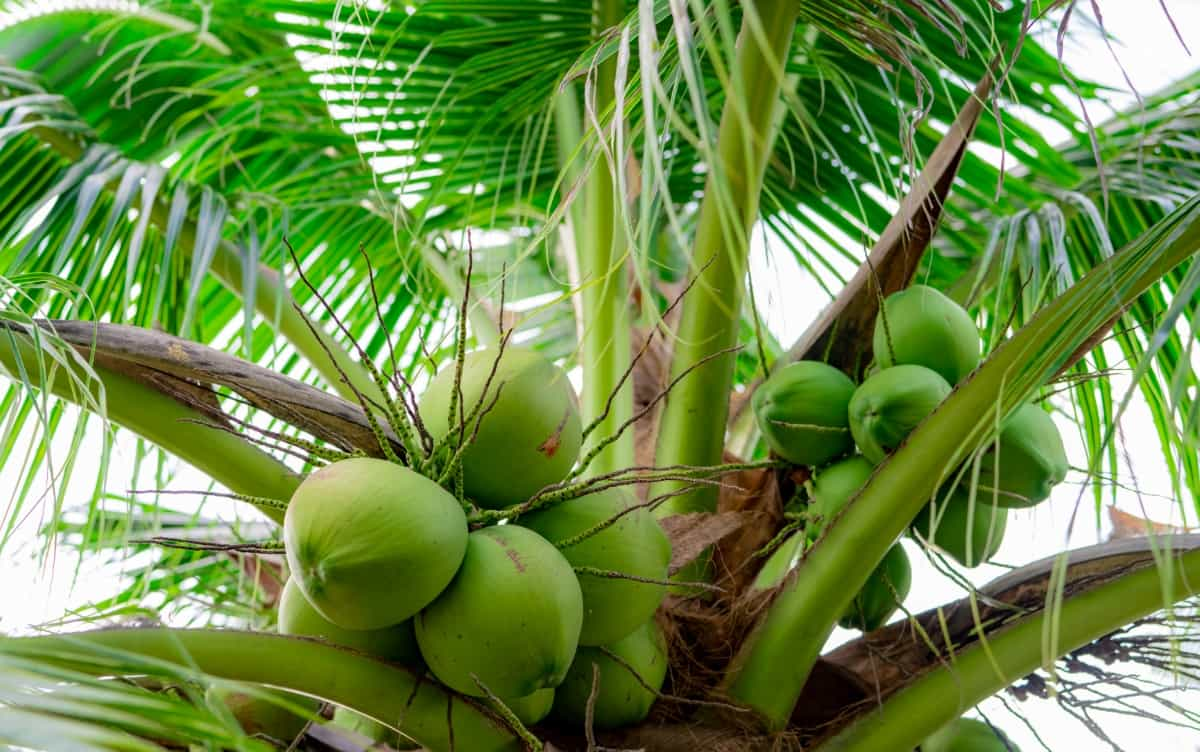
Understanding Coconut Botany
The Coconut palm, scientifically known as Cocos nucifera (L.), belongs to the Arecaceae family. It is a versatile plant with various parts used for different purposes – from the fruit for consumption to the leaves for roofing material. The Coconut tree has a tall, slender trunk topped with long, pinnate leaves that can grow up to 20 meters in height. Its flowers are small and white, and it produces large spherical fruits known as Coconuts.
Each part of the Coconut palm serves a unique function in sustaining its growth and reproduction. Coconut palms thrive in tropical climates due to their high tolerance for salty soil conditions and coastal environments. They require adequate sunlight, warm temperatures, and consistent rainfall throughout the year to flourish.
Optimal Climatic Conditions for Coconut
Coconut thrives in tropical climates with consistent warmth and humidity. The optimal climatic conditions for Coconut cultivation include temperatures from 20 to 30°C throughout the year. These palms require ample sunlight for proper growth, making regions near the equator ideal for their cultivation.
Rainfall is crucial; a well-distributed annual rainfall of around 2000 to 2500 mm ensures sufficient moisture for healthy Coconut trees. Coconuts are vulnerable to strong winds and storms, so planting them in areas shielded from such harsh weather conditions is essential. Coastal areas provide the perfect combination of sandy soil and saline water necessary for robust Coconut growth.
Soil Types and Preparation for Coconut Cultivation
Coconuts thrive in well-drained sandy or loamy soils with good water-holding capacity. Before planting, ensure the soil is rich in organic matter and pH level of 5.0 and 8.0. Properly preparing the soil involves clearing weeds or debris, tilling the land to loosen compacted soil, and incorporating organic fertilizers like compost or manure.
In case you missed it: Coconut Production – A Month Wise Practices
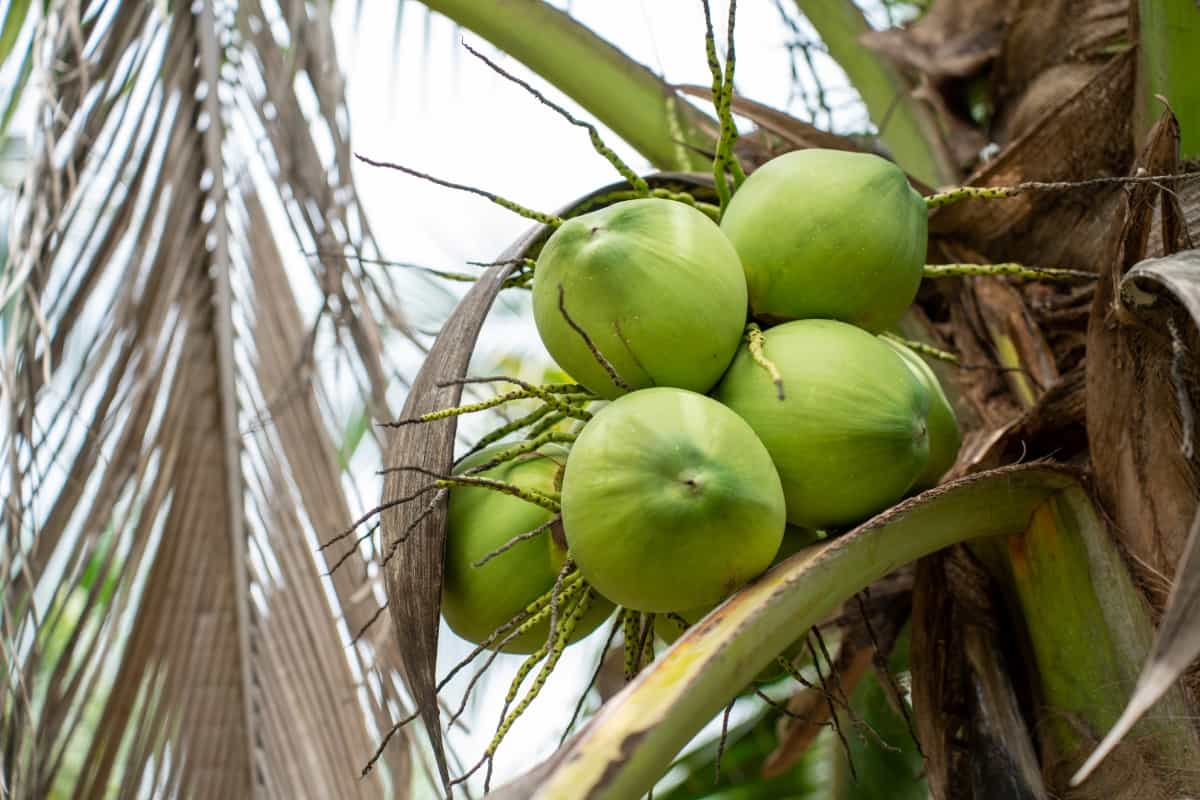
This helps improve soil fertility, providing a healthy environment for Coconut trees to grow. Coconut cultivation also benefits from adding micronutrients like boron, zinc, and magnesium based on soil test results. Additionally, maintaining optimal moisture levels in the soil through irrigation practices is essential for healthy Coconut tree growth.
Coconut Varieties/Types
Various Coconut varieties are cultivated worldwide, each with unique characteristics and uses. Some popular varieties include the Malayan Dwarf, King Coconut, and Jamaica Tall. The Malayan Dwarf is known for its high-yielding capacity and resistance to diseases.
The King Coconut is famous for its sweet water content and bright orange husk color, making it a favorite in tropical regions. On the other hand, the Jamaica Tall variety is preferred for its strong resilience against harsh weather conditions. Other notable types include the West Coast Tall, Chowghat Orange Dwarf, and Vanimo Green.
Propagation Techniques for Coconut Trees
One common method is through seed germination, where mature Coconuts are collected for planting purposes. The seeds should be soaked in water for a few days before sowing to promote sprouting. Another technique is to use seedlings or nursery-raised plants. These young Coconut plants are carefully nurtured in controlled environments until they are ready to be transplanted into the field. This method ensures quicker establishment and uniform growth across the plantation.
In some cases, vegetative propagation techniques like stem cutting or tissue culture may also be employed for specific purposes, such as maintaining desirable traits or rapid multiplication of elite varieties. Each propagation technique has its own set of requirements and benefits, allowing farmers to choose the most suitable method based on their goals and available resources.
Planting Methods and Spacing
Planting can be done using either seedlings or direct seeds, with seedlings being the preferred choice for better quality control. Proper spacing between Coconut trees is essential to allow each tree enough space to grow without competing for sunlight, nutrients, and water. The recommended spacing between Coconut trees varies depending on the variety and soil fertility but generally ranges from 7-9 meters apart.
This ensures adequate airflow and sunlight penetration while also facilitating ease of maintenance activities such as pruning and harvesting. Before planting, it is important to prepare the soil by loosening it up to promote root development and incorporating organic matter for improved nutrient uptake. Proper planting depth is key to preventing root suffocation while allowing for the stable anchorage of the tree.
Irrigation Management in Coconut Farming
Irrigation management plays a crucial role in Coconut farming, ensuring the trees receive adequate water for optimal growth and productivity. Coconut trees require consistent moisture levels, especially during dry periods, to thrive. Proper irrigation helps in maintaining soil moisture balance and prevents water stress. Drip irrigation is commonly used in Coconut plantations as it delivers water directly to the roots, promoting efficient water usage and reducing wastage.
In case you missed it: Innovative Strategies for Boosting Coconut Pollination and Yield
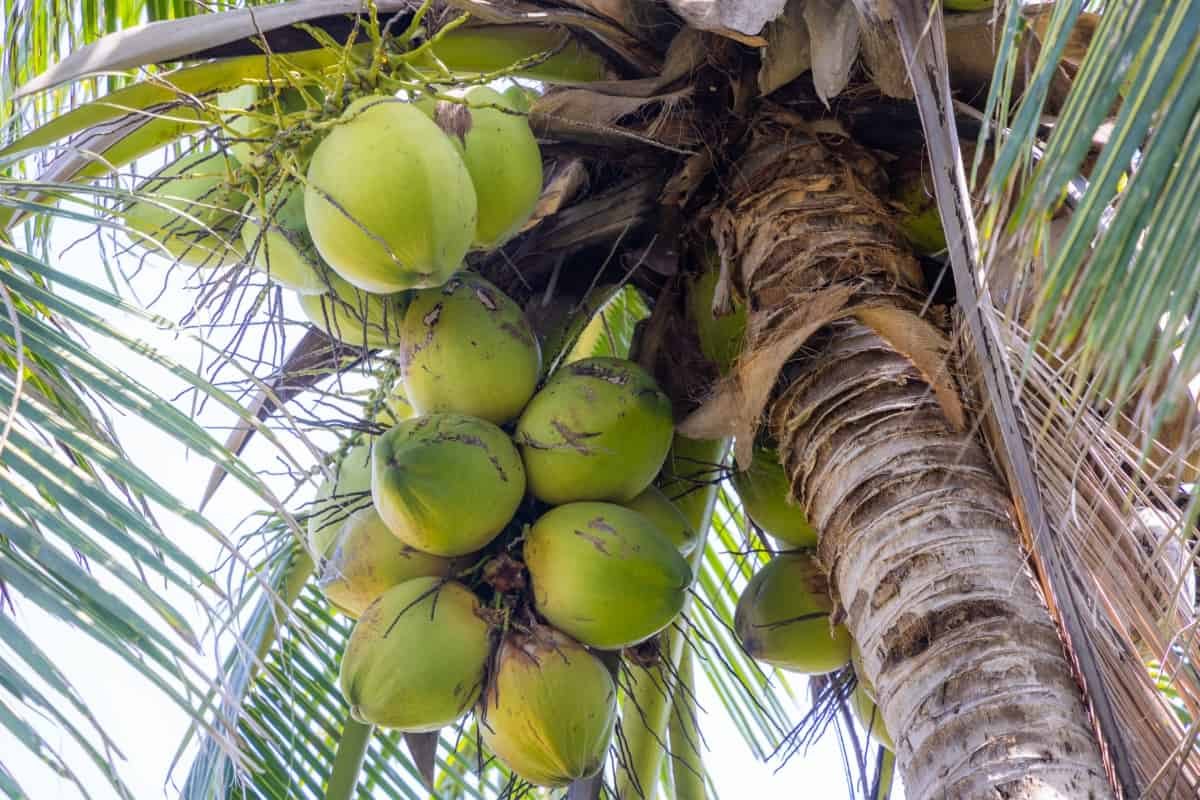
Monitoring soil moisture levels is important to adjust irrigation schedules accordingly and prevent both overwatering and underwatering. Rainfall patterns should also be considered when planning irrigation schedules to supplement natural precipitation effectively. Proper drainage systems are necessary to prevent waterlogging, which can lead to root suffocation and nutrient deficiencies. By implementing effective irrigation management practices, Coconut farmers can ensure healthy tree growth and maximize yield potential.
Nutrient Requirements and Fertilization Practices
Coconuts require a balanced supply of nutrients to thrive and produce high-quality yields. Key nutrients for Coconut trees include nitrogen, phosphorus, potassium, magnesium, calcium, and sulfur. Fertilizers can help replenish the soil with these essential nutrients that may be lacking naturally. Organic fertilizers are beneficial for long-term soil health and sustainability. Inorganic fertilizers can provide a nutrient boost when needed.
Conduct soil tests regularly to determine the specific nutrient needs of your Coconut plantation. You can tailor your fertilizer application to meet those requirements accurately. Over-fertilization of Coconut can lead to nutrient imbalances and environmental issues like water pollution. Therefore, it’s essential to follow recommended dosage guidelines and fertilize responsibly for optimal growth and productivity in your Coconut farm.
Integrated Pest and Disease Management
Pests and diseases can wreak havoc on Coconut farms, affecting both the quality and quantity of the harvest. Some common pests include Coconut mites, rhinoceros beetles, and red palm weevils. These insects can cause significant damage to Coconut trees if not properly managed. Coconut trees are susceptible to fungal infections like root wilt disease and leaf blight. Proper monitoring and timely treatment are essential in preventing these diseases from spreading throughout the plantation.
Integrated pest and disease management is crucial in maintaining a healthy crop without relying solely on chemical interventions. By combining biological, cultural, and chemical pest control methods, farmers can effectively manage pests while minimizing environmental impact. Additionally, practicing good sanitation by removing diseased plant material can help prevent the spread of infections. Crop rotation with non-host plants can also disrupt pest life cycles.
Inter-cropping and Crop Rotation Strategies
By planting compatible crops between Coconut trees, farmers can maximize land use efficiently. These inter-crops can provide additional income while the Coconut trees mature. Crop rotation involves rotating different crops on the same land to enhance soil fertility and reduce pests and disease buildup. It helps maintain soil health by preventing nutrient depletion.
In case you missed it: Best Fertilizer for Coconut Trees: Organic, NPK, Compost Manure, Dose, and Schedule
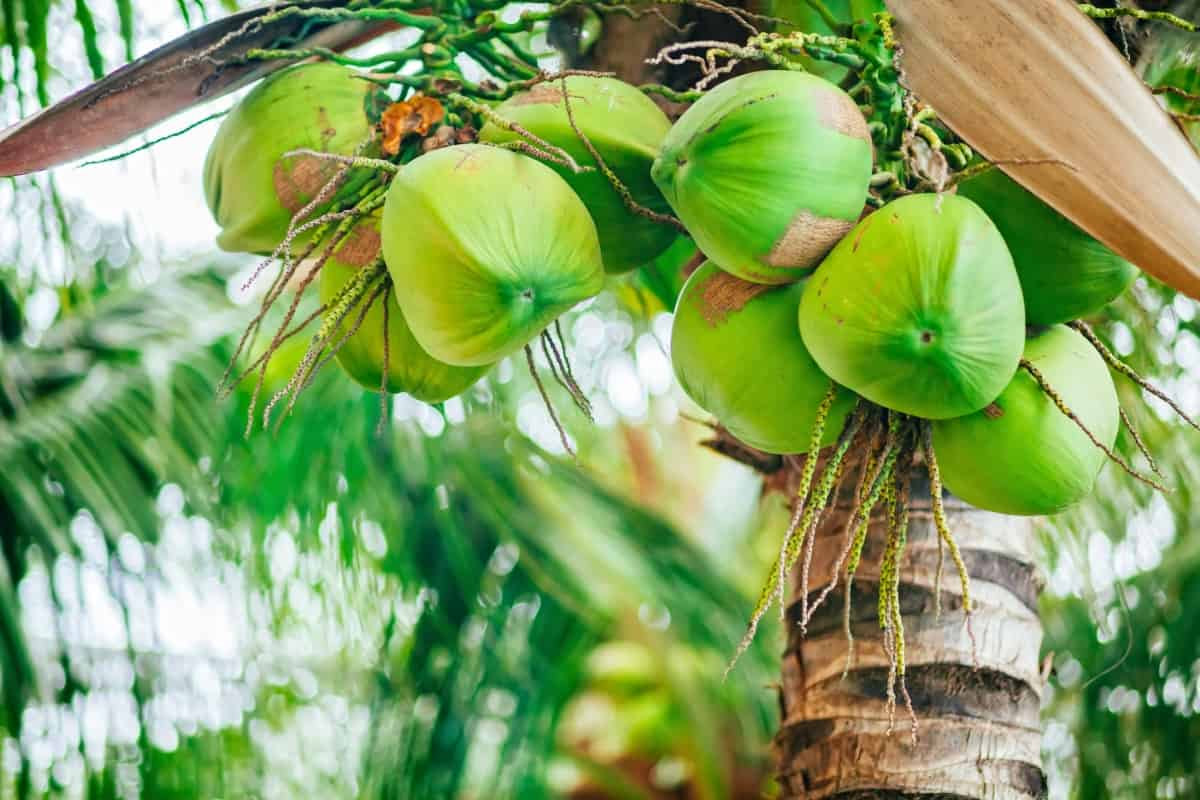
Some popular inter-crops for Coconut farming include legumes like beans and peas, root vegetables such as sweet potatoes, or even fruits like papaya and banana. These plants not only complement each other but also benefit from the shade provided by the taller Coconut trees.
Pruning and Maintenance of Coconut Trees
Pruning and maintenance of Coconut trees are essential tasks to ensure healthy growth and optimal yield. Regular pruning helps in removing dead or diseased fronds, allowing for better air circulation and sunlight penetration. It also promotes the growth of new fronds and facilitates easier harvesting. When it comes to maintenance, keeping the area around the Coconut tree free from weeds is crucial.
Weeds compete with the Coconut tree for nutrients and water, potentially hindering its growth. Regular weeding is necessary to prevent weed infestation. Monitoring for Coconut pests and diseases is another important aspect of maintenance. Early detection can help prevent widespread damage to the Coconut plantation. Implementing integrated pest management techniques can effectively control pests without harming the environment.
Harvesting and Yield Optimization
The ideal time to harvest Coconut fruits is when they are about 10-12 months old. At this stage, the Coconut will have maximum water content and a soft kernel inside. Harvesting Coconut too early or too late can affect the quality of the Coconut. To optimize yield, use sharp tools for harvesting to avoid damaging the tree or fruits. It’s also important to handle the Coconuts with care during harvesting, as bruises or cuts can lead to spoilage.
After harvesting, it’s crucial to store the Coconuts properly in a cool and dry place to maintain their freshness and prevent mold growth. Proper storage conditions also play a significant role in optimizing yield and extending shelf life.
Average Yield of Coconuts
Coconuts are known for their high-yield potential. Each tree can produce an average of 50 to 80 Coconuts per year. However, the yield can change based on various factors, such as the age and health of the tree, environmental conditions, and proper management practices. Young Coconut trees may take several years to reach full production capacity, but once matured, they can sustain consistent yields for decades.
In case you missed it: Growing Dwarf Coconut Trees – A Complete Guide
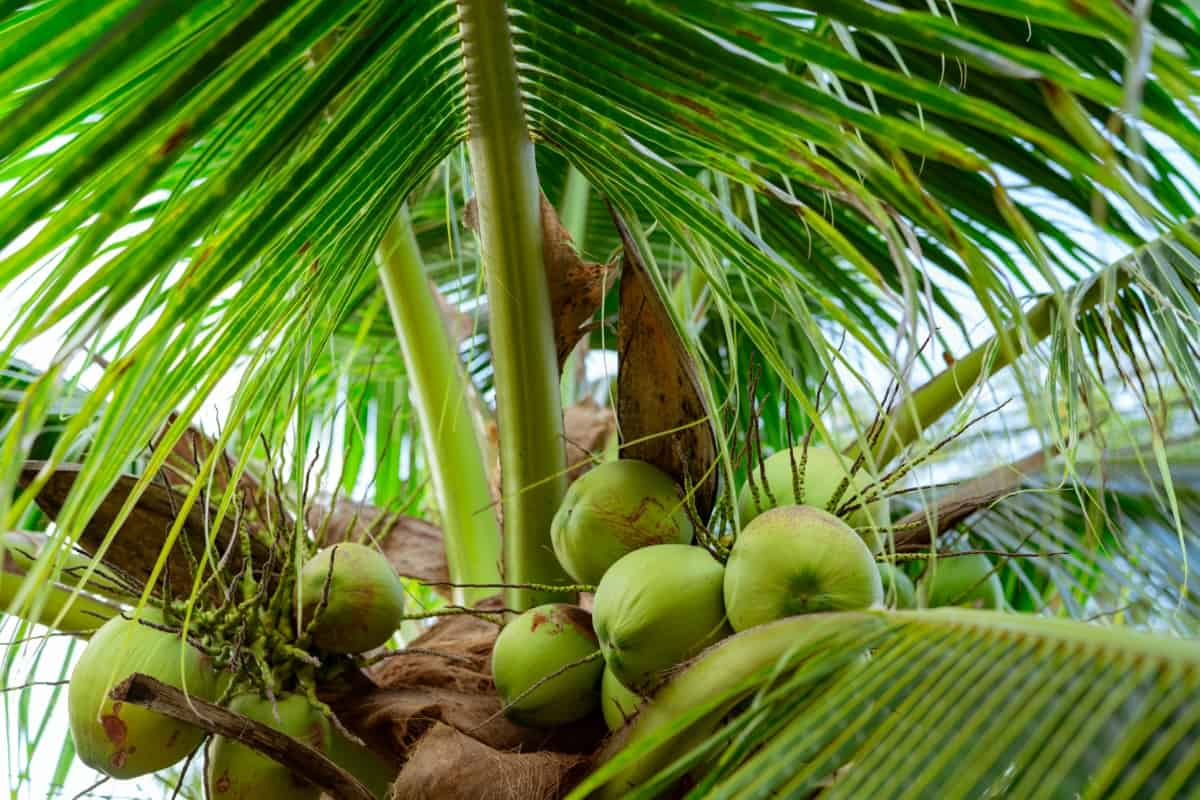
Regular pruning and fertilization play a crucial role in maintaining optimal production levels. In some regions with favorable growing conditions, Coconut plantations have been reported to achieve even higher yields, exceeding 100 Coconuts per tree annually. This demonstrates the resilience and productivity of this tropical crop when well cared for.
Tips to Boost Coconut Yield
Firstly, consider investing in high-quality seeds or seedlings from reputable sources. Starting with healthy and disease-resistant plants can set the foundation for a successful harvest. Proper irrigation is crucial for Coconut trees. Ensure they receive sufficient water, especially during dry periods, but be cautious of overwatering, which can lead to root rot. Monitor soil nutrient levels regularly and provide appropriate fertilization based on soil tests. Balanced nutrition is key to promoting growth and increasing yields.
Implement effective pest and disease management practices to protect your Coconut trees from common threats. Regular scouting and prompt action are essential. Pruning old or diseased fronds helps improve air circulation around the tree canopy, allowing for better sunlight penetration, which promotes fruit development. Maintain good hygiene practices in your orchard by removing fallen leaves and debris regularly to prevent the spread of diseases.
Post-Harvest Handling and Processing
After harvesting the Coconuts, they need to be handled carefully to maintain quality. The first step is to remove the husk and shell to access the white flesh inside. Harvesting can be done manually or using machinery, depending on the scale of production. Once extracted, the Coconut flesh can be processed into various products like desiccated Coconut, Coconut milk, oil, and water.
Each product requires specific processing methods to ensure quality and taste. Desiccated Coconut involves drying the grated flesh while making Coconut oil involves pressing it for extraction. Proper storage is essential for post-processing to prevent spoilage. Products are stored in a dry place away from direct sunlight. Packaging also plays a major role in maintaining freshness and extending shelf life.
Marketing Strategies for Coconut Products
Utilize social media platforms to showcase the versatility of Coconuts – from skincare products to culinary delights. Consider packaging design that reflects the natural and eco-friendly qualities of Coconuts. Participate in trade shows and farmer’s markets to connect directly with consumers and educate them about the benefits of Coconut products.
In case you missed it: High Density Coconut Plantation – Spacing, Yield
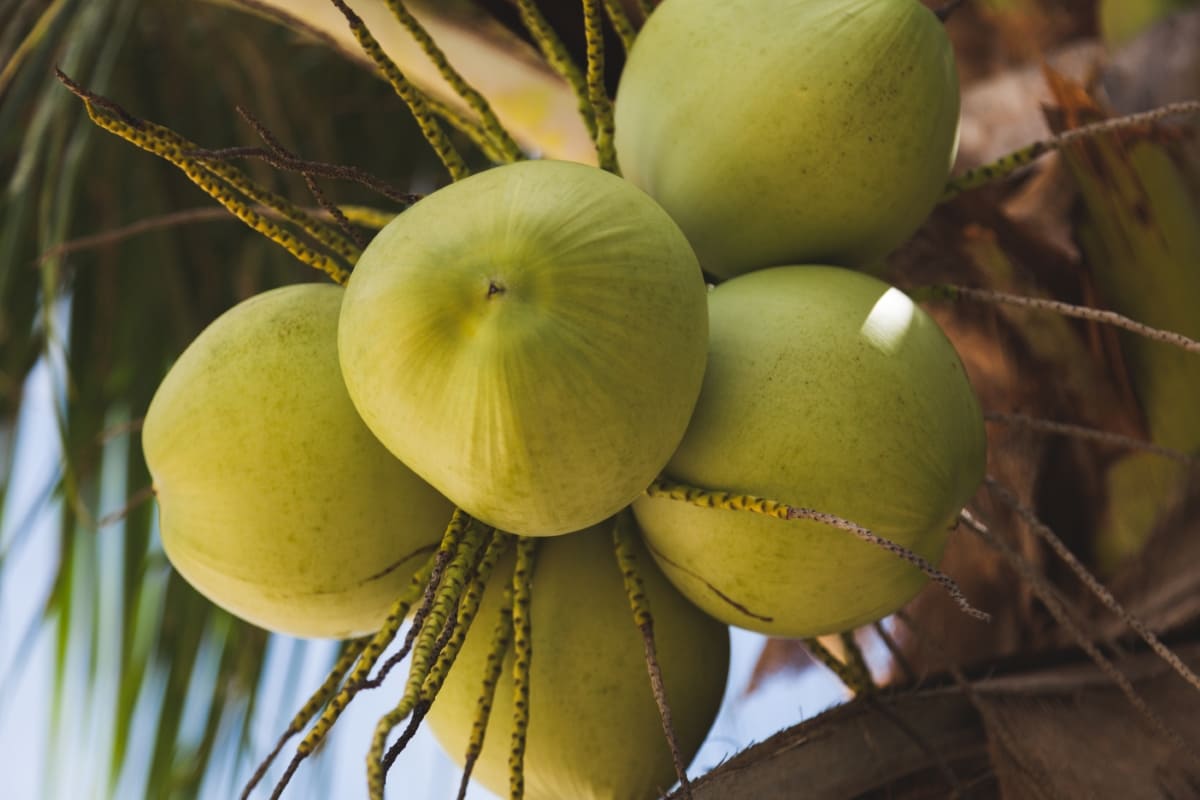
Offer sample sizes or trial packs to encourage first-time buyers to experience the goodness of Coconuts. Partner with local stores or specialty shops for distribution, making it easier for customers to access your Coconut offerings. Stay updated on consumer preferences to tailor your marketing strategies accordingly, ensuring sustained interest in Coconut products.
Sustainability in Coconut Farming
Sustainability in Coconut farming is crucial for the long-term health of both the environment and the industry. Farmers are increasingly adopting sustainable practices to ensure a balance between productivity and environmental stewardship. Implementing organic farming methods, such as using natural fertilizers and pesticides, helps reduce chemical runoff into water sources. Additionally, practicing crop rotation can help maintain soil fertility and prevent diseases.
Investing in renewable energy sources can decrease reliance on fossil fuels, reducing greenhouse gas emissions. Water management techniques like drip irrigation also play a significant role in conserving water resources. Coconut farming presents numerous opportunities for small-scale and large-scale growers alike. However, successful Coconut farming requires careful attention to detail at every stage, from selecting quality seeds to implementing effective cultivation practices and post-harvest management.
- Economical Aquaculture: A Guide to Low-Budget Fish Farming
- 15 Common Planting Errors That Can Doom Your Fruit Trees
- How to Make Houseplants Bushy: Effective Tips and Ideas
- Innovative Strategies for Boosting Coconut Pollination and Yield
- Pollination Strategies for Maximum Pumpkin Yield
- The Complete Guide to Chicken Fattening: Strategies for Maximum Growth
- Natural Solutions for Tulip Problems: 100% Effective Remedies for Leaf and Bulb-Related Issues
- Revolutionizing Citrus Preservation: Towards a Healthier, Greener Future
- Natural Solutions for Peony Leaf and Flower Problems: 100% Effective Remedies
- Maximizing Profits with Avocado Contract Farming in India: A Comprehensive Guide
- Natural Solutions for Hydrangea Problems: 100% Effective Remedies for Leaf and Flowers
- The Ultimate Guide to Choosing the Perfect Foliage Friend: Bringing Life Indoors
- From Sunlight to Sustainability: 15 Ways to Use Solar Technology in Agriculture
- The Ultimate Guide to Dong Tao Chicken: Exploring from History to Raising
- The Eco-Friendly Makeover: How to Convert Your Unused Swimming Pool into a Fish Pond
- Mastering the Art of Delaware Chicken Farming: Essentials for Healthy Backyard Flocks
- 20 Best Homemade Fertilizers for Money Plant: DIY Recipes and Application Methods
- How to Craft a Comprehensive Free-Range Chicken Farming Business Plan
- Brighten Your Flock: Raising Easter Egger Chickens for Beauty and Bounty
- How to Optimize Your Poultry Egg Farm Business Plan with These Strategies
- Subsidy for Spirulina Cultivation: How Indian Government Schemes Encouraging Spirulina Farmers
- Ultimate Guide to Raising Dominique Chickens: Breeding, Feeding, Egg-Production, and Care
- Mastering the Art of Raising Jersey Giant Chickens: Care, Feeding, and More
- Ultimate Guide to Raising Legbar Chickens: Breeding, Farming Practices, Diet, Egg-Production
- How to Raise Welsummer Chickens: A Comprehensive Guide for Beginners
- How to Protect Indoor Plants in Winter: A Comprehensive Guide
- Ultimate Guide to Grow Bag Gardening: Tips, Tricks, and Planting Ideas for Urban Gardeners
- Guide to Lotus Cultivation: How to Propagate, Plant, Grow, Care, Cost, and Profit
- Agriculture Drone Subsidy Scheme: Government Kisan Subsidy, License, and How to Apply Online
- Ultimate Guide to Raising Araucana Chickens: Breed Profile, Farming Economics, Diet, and Care
- Bringing Hydroponics to Classroom: Importance, Benefits of Learning for School Students
- Ultimate Guide to Raising Polish Chickens: Breed Profile, Farming Economics, Diet, and Care
- Ultimate Guide to Raising Australorp Chickens: Profile, Farming Economics, Egg Production, Diet, and Care
- Silkie Chicken Farming: Raising Practices, Varieties, Egg Production, Diet, and Care
- Sussex Chicken Farming: Raising Practices, Varieties, Egg Production, Diet and Care
- Homemade Feed Formulations for Livestock: Discover Cost-effective Starter to Finisher Feed Recipes
Can you please suggest me what are profitable crops to cultivate in water logged lands? In my field the water will be logged for 4 months a year. Please suggest me the profitable crop in this scenario.
My field is in andhra pradesh krishna district
Paddy/Rice is one of the best for you. OR Banana Farming.
There are stories that it’s best to plant your nut tree three days before or after the full moon…. does this have any effect on the tree?
I am a beginner in coconut (dwarf variety) planting. Can you advice what organic and also chemical fertilizers is/are recommended for better faster growth and good abundant fruiting? My soil types are, a little bit sandy, clayey, alluvial and loamy. Weeding the weeds in between: what do you recommend, using weedicides, if so, what types/brands and if spraying, how far from the tree?
What is 18 patta Keralian coconut tree. Pls give suggestions for its plantation & maintenance. Can I plant it in big pot? How long will it take to give coconuts?
I am a coconut farmer for about 30 years and I would like to seek your advice of how to increase the yeild and make coconut cultivation more profitable.I have planted my garden@ 3meters apart for each tree.The age of the trees would be about 30-35 years old.
I water the field by drip irrigation and I have stopped using fertilizers for the past 5-7years and using only crowdung ,goatpellets,neem cake mixed with groundnut cake,Panchkavya and vermicompost.and controlling the rhinosaur I use Kottomuthu (castor seed)punnakku and for controlling weevil Beatles 10ml of monocrotophos through the roots of the trees
Dwarf coconut plant supplyer s contact number
I am from Pune India. Can you please suggest to me where I can get the Dwarf variety of coconut tree saplings. I want to plant them on 1 acre.
Hello, please I need 300 seedlings of the dwarfs coconut variety. I am Ochelle Paul Ohini from Nigeria
I am interested in dwaft coconut plantation….
I have a coconut tree which is almost 14 ft high. I planted it around 20 years ago and it has grown well till today. The big problem that I have is that it does not yield coconuts! The small fruit appears in bunches on all four sides of the top tree, but withers and dies soon. What could be the problem?
The leaves are healthy and so is the tree. Kindly help me or else I will have to cut the tree down.
How to control pre mature falling of young coconut and how to control falling of flowers.
Can you please advise, Will plugging tender coconut reduces the life span of the trees or any other damage will happen to the trees
How to Make Coconuts plantation at River Sandy char with 3 months Water logged areas od Sandy char
I want to get a reliable coconut farmer to partner with to farm coconut in Nigeria.
I want to start a coconut plantation in Mauritus and I would like to have some simple advice and information
-about how to grow
-look after
As I have never done it before.
Your support will be very much appreciated.
Thanks
Ravi